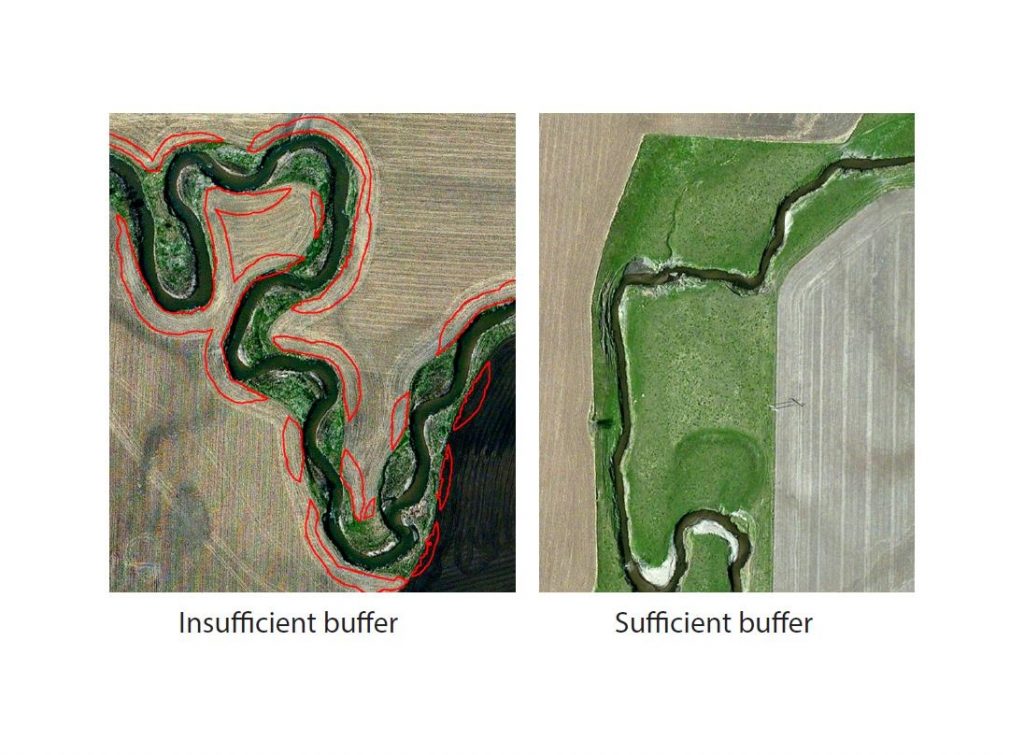
News
MN buffer initiative targets water quality
April 10, 2015 By State of Minnesota
 This aerial image offers a bird's eye view of adequate versus inadequate buffer strips. The Land of 10
This aerial image offers a bird's eye view of adequate versus inadequate buffer strips. The Land of 10Apr. 10, 2015, St. Paul, MN – The Land of 10,000 Lakes may soon establish an additional 125,000 acres of water quality buffer strips statewide, if a proposal from Governor Mark Dayton becomes law.
Dayton introduced legislation requiring 50-foot water quality buffer strips around Minnesota’s lakes, rivers, and streams. The law is co-authored by Rep. Paul Torkelson and Sen. John Marty and is designed to prevent pollution from entering the state’s waters.
“The state’s existing rules on buffer strips are inconsistent, and they are enforced inconsistently – which almost always guarantees failure,” Dayton said. “The strengths of my proposal are its simplicity and common sense. People have the right to do follow lawful practices on their private properties; however, they should not have the right to contaminate waters that all of us depend upon.”
The legislation would require at least 50 feet of perennial vegetation – otherwise known as water quality buffer strips – to surround lakes, rivers, and streams throughout the state. Buffer strips are designed to help filter out phosphorus, nitrogen, and sediment by slowing runoff and trapping polluted sediment. Buffer strips then allow vegetation to absorb any pollutants, preventing them from entering the water supply. Statewide, the Governor’s proposal would require that 125,000 acres of land adjacent to water be designated for buffer strips and covered in permanent vegetation.
“Minnesotans can think of water quality buffer strips as water filters for the landscape,” said Department of Natural Resources (DNR) Commissioner Tom Landwehr. “Protecting this relatively small amount of acreage, lying along our waterways, has the potential to significantly improve water quality for drinking, fishing, swimming and other everyday uses. It is our best and simplest strategy to protect our waters for this generation, and the generations of Minnesotans who come after us.”
Understanding the problem
The most recent analysis from Minnesota’s Board of Water and Soil Resources (BWSR) estimates 64 per cent of all waters in the southern and western regions of Minnesota are not subject to any buffer requirements under current law. Additionally, the Minnesota Pollution Control Agency (MPCA) estimates only 43 per cent of rivers and streams in western and southern Minnesota have vegetated buffers.
“Implementing buffer strips will help prevent the continued degradation of our waterways,” said Dave Frederickson, agriculture commissioner. “This proposal is good for Minnesota and it also sends the right message to our neighboring states in the Mississippi River basin that are looking to us for leadership.”
Some areas of the state are already doing well to establish adequate buffer strips around their area water bodies. Through education and landowner agreements, Dakota County has successfully achieved a 99 per cent compliance rate with 50-foot buffer strips around its water bodies. In Dodge County, about 80 per cent of its river and stream banks have buffers, thanks to a comprehensive county-wide education and compliance campaign.
“We have already seen very successful buffer establishment efforts in several Minnesota counties,” said John Jaschke, executive director of BWSR. “We know this approach can work.”
Dayton’s water quality buffer strip proposal would build on the lessons of these local success stories, and provide the requirements, resources, monitoring, and enforcement necessary to successfully create and preserve 50-foot buffers statewide.
Funding available
Local, state, and federal program dollars are available to landowners to implement buffer strips on their properties – including federal dollars from the Conservation Reserve Program and practice implementation programs like the Environmental Quality Incentives Program. If a landowner does not implement buffer strips within the given time period, the DNR would require that any violations be corrected and assess monetary penalties for failure to comply with the law.
This proposal is based on recent studies looking at the extent of Minnesota’s waters subject to current buffer requirements, and the additional buffers needed to address water quality improvements. Input was gathered from stakeholder input meetings with agriculture groups, environment and conservation organizations, and federal, state, county, and other local government representatives.
The Minnesota Department of Natural Resources has created a new informational website to help people better-understand how water quality buffer strips work, and what the proposal would do to improve water quality across Minnesota. The site includes diagrams, an interactive map demonstrating vegetation coverage statewide, and a frequently asked questions guide.
A fact sheet is also available.
Print this page